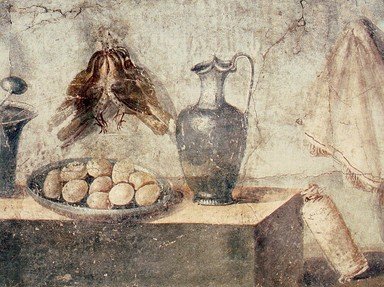Quiz Answer Key and Fun Facts
1. The Ancient Romans generally ate three meals, of which "cena" was the most important. What kind of meal was it?
2. Grain-based foods, such as a porridge called "puls" and various kinds of bread, were among the staples of Roman cuisine. What grain, a type of wheat, was used to make these basic foods?
3. The Romans also ate many vegetables, though some of those that are now associated with the Mediterranean diet were not yet known at the time. Which of these vegetables, still a mainstay of the cuisine of modern-day Rome, would you have found on a Roman table?
4. Various kinds of meat were featured on the Roman table. A whole chapter of Apicius' famed cookbook "De re coquinaria" is dedicated to which tasty meat-based preparations, beloved of grilling aficionados?
5. Besides meat and seafood, the Romans enjoyed other sources of protein that now would be viewed as not for the faint of heart. What invertebrates (still popular in France) were farmed extensively around Rome?
6. Nuts grow abundantly in the Mediterranean basin, and were used by the Romans in savoury and sweet dishes. An especially delicious sauce or spread called "moretum", which also included cheese, garlic, and herbs, is considered by some to be the ancestor of which well-known Italian pasta sauce?
7. No quiz about Ancient Roman cuisine would be complete without a mention of "garum", a pungent condiment that could command very high prices. Which modern condiment, widespread in Southeast Asia, resembles it most?
8. A wide variety of desserts were enjoyed in Ancient Rome, even though refined sugar or fresh butter were not available to Roman pastry cooks. One of these, called "placenta", was one of the earliest versions of which luscious modern dessert, often associated with New York City?
9. In Ancient Rome, wine was normally mixed with water before drinking. The everyday drink of soldiers and the lower classes, however, was an acidic concoction called "posca", which appears in the narration of the Passion of Jesus Christ. What was its main ingredient?
10. Not all Roman citizens had access to a fully equipped kitchen, and those who lived in apartment buildings availed themselves of a number of establishments viewed as the forerunners of modern fast food restaurants, pubs, and wine bars. How were these places generally regarded?
Source: Author
LadyNym
This quiz was reviewed by FunTrivia editor
Bruyere before going online.
Any errors found in FunTrivia content are routinely corrected through our feedback system.
